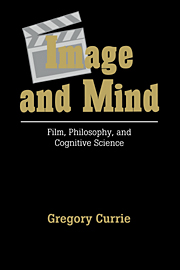Book contents
- Frontmatter
- Contents
- Preface
- Acknowledgements
- Film, 1895–1995
- Image and mind
- Introduction: the essence of cinema
- Part I Representation in film
- Chapter 1 The myth of illusion
- Chapter 2 The imprint of nature
- Chapter 3 Realism
- Chapter 4 Languages of art and languages of film
- Part II Imagination
- Part III Interpretation
- In conclusion
- Named propositions
- Bibliography
- Index
Chapter 4 - Languages of art and languages of film
Published online by Cambridge University Press: 28 October 2009
- Frontmatter
- Contents
- Preface
- Acknowledgements
- Film, 1895–1995
- Image and mind
- Introduction: the essence of cinema
- Part I Representation in film
- Chapter 1 The myth of illusion
- Chapter 2 The imprint of nature
- Chapter 3 Realism
- Chapter 4 Languages of art and languages of film
- Part II Imagination
- Part III Interpretation
- In conclusion
- Named propositions
- Bibliography
- Index
Summary
… the proper objects of sight are lights and colours, with their several shades and degrees; all which, being infinitely diversified and combined, form a language wonderfully adapted to suggest and exhibit to us the distances, figures, situations, dimension, and various qualities of tangible objects: not by similitude, nor yet by inference of necessary connection, but by the arbitrary imposition of providence, just as words suggest the things signified by them.
George BerkeleyThat the medium of cinematic images is in some sense pictorial is hardly controversial. But many will object to the sharp distinction I have drawn between the pictorial and linguistic, a distinction Berkeley apparently seeks to undermine in the quotation above. That distinction is rejected by almost every consciously theoretical writer on film, and on art and culture generally. The prevailing view is that picturing is a mode of representation at least very like linguistic representation, that images in general and cinematic images in particular operate by means of codes or conventions that are like the semantic and syntactic rules of a language. Berkeley's view that the appearances of things form a kind of arbitrary code, and that seeing is therefore a kind of reading, is one which, shorn of its theological trappings, many contemporary theorists of cinema would endorse.
This idea of the ubiquity of language is so entrenched that expressions like “the grammar of quattrocento painting”, “the vocabulary of Gothic architecture” and “the language of film” do not strike us as peculiar or in need of justification.
- Type
- Chapter
- Information
- Image and MindFilm, Philosophy and Cognitive Science, pp. 113 - 138Publisher: Cambridge University PressPrint publication year: 1995



